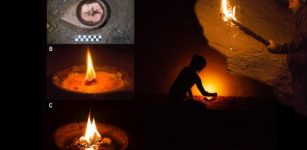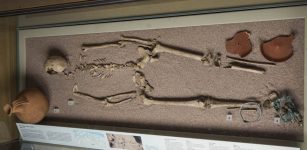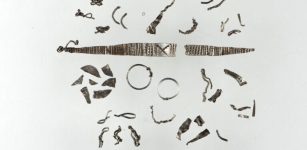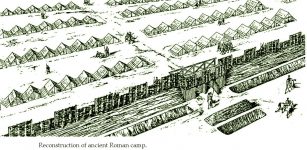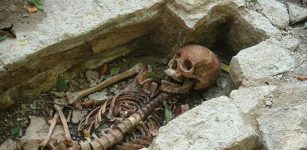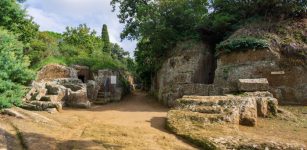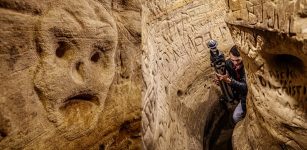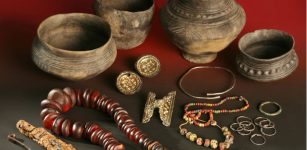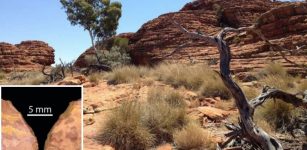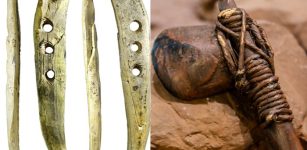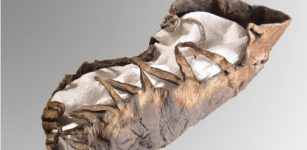Three Ingots Shed Light On The Mining Exploitation Of The Sierras de Córdoba Mountain Range
Conny Waters - AncientPages.com - The discovery of three ingots from the site of Los Escoriales de Doña Rama (Belmez), dating back to the Roman era, clearly shows the significance of lead production and exportation in the northern region of Córdoba.
Three ingots that demonstrate the importance of lead production and exportation in northern Cordoba. Credit: University of Cordoba
These ingots measure about 45 centimeters long and weigh between 24 and 32 kilograms. They have a triangular shape and resemble a Toblerone bar.
The examination of the three lead ingots (one of them is broken in half) provides sufficient evidence to assert that ancient Córdoba was a preeminent center for lead smelting in the western ancient world. Lead, a versatile metal, was widely utilized in producing numerous everyday implements, including utensils such as spoons, tiles, pipes, and other essential items.
The ingots, originating from the first century AD were excavated in the twentieth century during the construction of the Maghreb-Europe gas pipeline.
These artifacts were subsequently housed in the Belmez Museum and private residences.
Ingot 1. SS Marks. (Image ©MEI-Heritage UCO Project). Source: University of Córdoba
Two of them bear distinctive markings an identifying mark, making it possible to reveal part of their history and to confirm the profound significance of mining activities in the central Sierra Morena region during the Roman era.
This mark is, in fact, a representation of two letters, "S S," which refer to the Societas Sisaponensis, a mining company that originated from La Bienvenida (Almodóvar del Campo, Ciudad Real), a region renowned for its production of cinnabar. However, it is presumed that the company's headquarters were situated in Córdoba.
Ancient Córdoba was the capital of the Roman Empire's region of Baetica, whose territory occupied what is today the north of the province, encompassing the Guadiato Valley, Los Pedroches, and some districts of Jaen, Ciudad Real and Badajoz.
The ingots' ingenious triangular shape not only facilitated an optimal storage capacity but also served as a testament to the advanced design of the time. The presence of lettering on the ingots further indicates their intended use for export.
Ingot 2. SS Marks. (Image ©MEI-Heritage UCO Project). Source: University of Córdoba
Their markings identified the producer. Subsequently, these marked ingots were destined for loading onto vessels, accompanied by other products.
The team's findings assert that the mining activity in northern Córdoba was not confined solely to the production of lead and silver, a fact previously established. Rather, it encompassed exportation as well, positioning the region among the principal producers of metals destined for Mediterranean trade. This conclusion underscores the broader scope and significance of the mining operations in the area.
The examination of the ingots' chemical composition and stable isotopes enabled the researchers to corroborate that they had undergone a desilvering process and that the ore utilized in their production originated from the Fuente Obejuna-Azuaga district, a prominent mining region including the Doña Rama site where the ingots were unearthed.
In essence, the three artifacts shared a common provenance intrinsically linked to the very location of their discovery.
The ingots’ discovery in the same region where they were manufactured is an exceptional occurrence, and the reason for this is unknown.
Most ingots of this nature have been unearthed at the depths of the Mediterranean Sea, at sites of shipwrecks, and it is precisely within these subaquatic realms that the research team has garnered the most substantial information since commencing their collaboration with specialists from the Université Toulouse. These specialists have dedicated years to studying the composition and cataloguing the ingots retrieved from these locations.
The analysis conducted indicates that a substantial proportion, exceeding fifty percent, of the ingots subjected to examination by the esteemed French specialists originated from the district of Fuente Obejuna-Azuaga.
This finding confirms the pivotal role played by the region of Córdoba as a prominent producer and exporter of lead ingots during the period under investigation.
According to UCO researcher Antonio Monterroso Checa, this information demonstrates that, in antiquity, these northern regions of Córdoba boasted major metallurgical networks of great commercial and economic importance in the Mediterranean."
"It reveals the level of industrialization, skill and knowledge necessary to reach that level of manufacturing."
Indeed, while there is still much to be explored and analyzed, the Doña Rama site appears to be a comprehensive mining settlement, encompassing a foundry, a processing area, and what could potentially be a fortified structure.
However, the further studies are needed to substantiate these preliminary observations.
The study is published in the Journal of Roman Archaeology.
Written by Conny Waters - AncientPages.com Staff Writer





